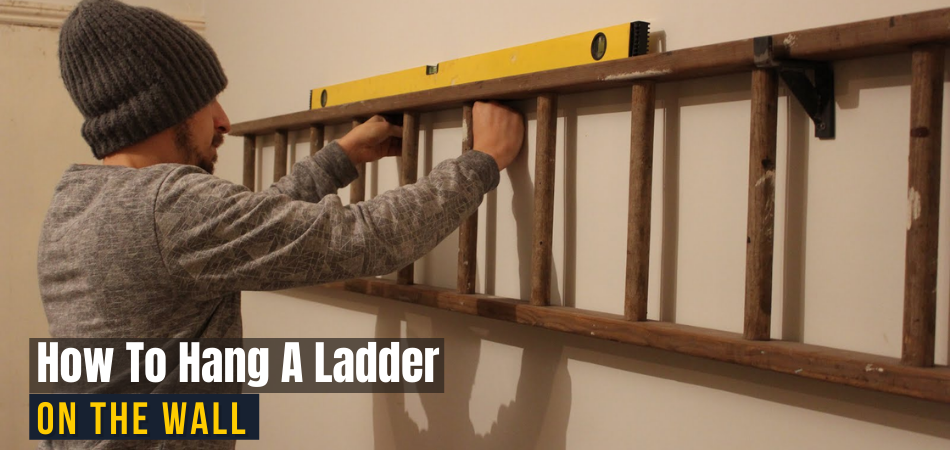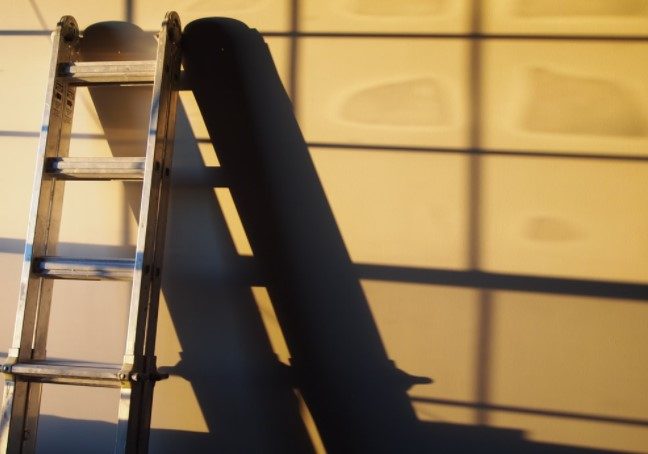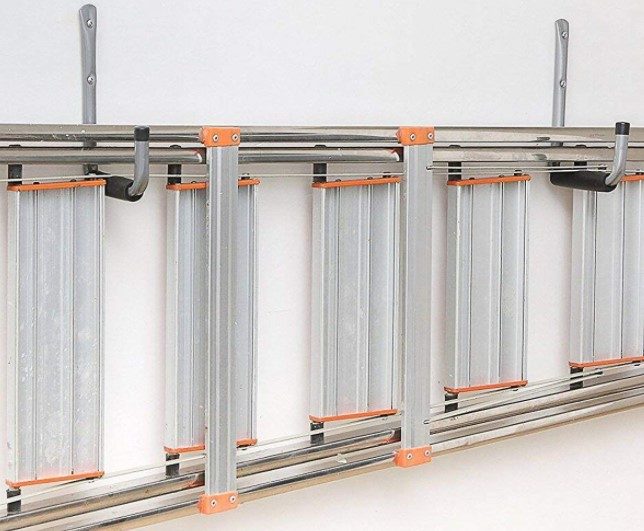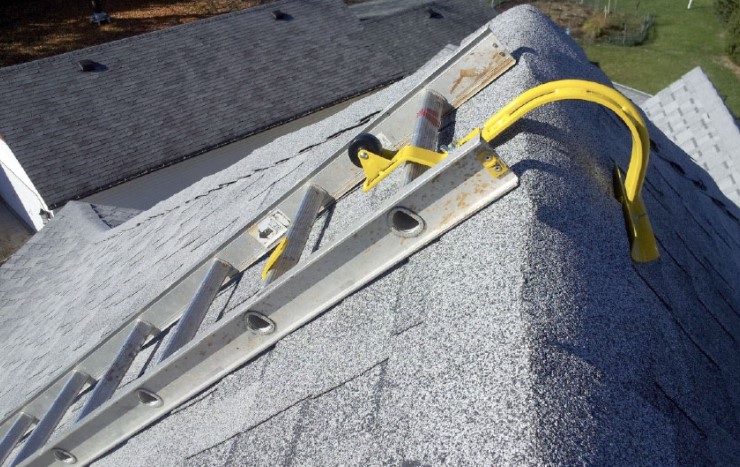If you want to hang a ladder on the wall for decoration or ladder for painting high stairwell, first use L-brackets to support the bottom rail. Next, place an additional set of brackets beneath the top rail. Get ladder storage hooks from your local construction supply shop, and use them to store your ladder on the wall. Find two studs in your wall using a stud finder and mark each location using a level. Install your racks between at least two studs so that your ladder will be supported at all times.
How To Hang A Ladder On The Wall
Once it comes to hanging a ladder on a wall, the technique to do this, has to be followed step by step to get the job properly done. Read on carefully, to find out exactly what to do.

1st Step:
You can buy an A-frame ladder from the hardware store that is 4-6 feet high. Use the ladder to climb a tall bookshelf, or use it to help fill a gap between shelves.
First, to hang a ladder on the wall, take the ladder apart. The seat will extend onto the rails, causing it to rest unevenly on the wall. Choose a ladder with a lovely wood grain that complements your home’s interior style; do not choose an A-frame ladder. Drill into spherical rails more easily than flat rails, which are preferable.
2nd Step:
Make sure the ladder will fit in the designated area by measuring it.
To hang a ladder:
- Place it against the wall horizontally.
- If the fit is tight, measure the length of your ladder using a measuring tape.
- Check to see whether there’s enough space for the ladder on your wall.
3rd Step:
Hanging a ladder on the wall requires discovering and locating the studs in your wall. Use a stud finder to record the locations of the studs in your wall. Stud finders beep or light up when they detect a stud hiding beneath the drywall.
When you measure between the studs, you’ll discover that the usual distance is sixteen inches (41 cm) or twenty-four inches (61 cm). Replace the batteries as soon as possible.
If you are hanging a ladder that weighs less than 20 pounds (9.1 kg) and does not plan to put anything on the ladder, skip installing the ladder on studs.
4th Step:
Mark the bracket placements that hold up the bottom rail of your ladder by using a level and a pencil. When you hold a group against the wall, make sure the bubble in the middle is in the centre—Mark three studs with your stud finder for security. Make a mark about 1–2 feet (30–61 cm) apart to ensure that the ladder is supported equally.
If you have help, this will be easier. Ask a friend or family member to hold the level while marking the wall.
Once you’ve determined the placement of each bracket and drill holes in the wall, hold the ladder up to make sure your markings do not overlap with the rungs.
5th Step:
L-shaped brackets should be drilled into the wall, facing the frames upward. [5] L-brackets, also known as L-shaped brackets, are strengthened metal components in the form of an L used to suspend large objects on a flat surface. Purchase L-brackets that are slightly narrower than your ladder’s rails and drill them into the wall at the designated positions. Install your L-brackets using 3-inch screws.
If you’re hanging a ladder on the wall, make sure that the bottom of the L-bracket is the part that sticks out.
If you’re hanging a small ladder with rails thinner than 3 inches (7.6 cm), 18-inch-long (2.9 cm) L brackets will work well.
6th Step:
If you want a smoother finish on your ladder, sand it with 80- to 150-grit sandpaper. If the ladder is often used, consider sanding the wood to prevent splintering. Put on your safety glasses and strong gloves, then get some 80- to 150-grit paper. To remove the outer layer of wood from the ladder, scrub it with strong back-and-forth strokes.
You can paint your ladder before attaching it to the wall if you wish. If you do, use acrylic paint and a brush to apply many layers until you’ve reached the desired texture and colour, then let it dry fully.
7th Step:
To mount a ladder on the wall, place the ladder on top of the L-brackets and secure it in place with screws. Lift the ladder slightly, set the bottom rail against the wall, and lower it gently until it is secure.
Use 12–1 in (1.3-2.5cm) screws to attach the ladder to the sections of the brackets that protrude from your wall. Drill gently into the wood with the lowest power setting.
Have a friend or family member brace the ladder after you’ve perforated it with your screw to hang a ladder. (Or use both hands to keep the ladder steady if you’re not able to get help.)
8th Step:
When hanging a ladder, drill extra mounting brackets into the wall where you want the ladder to hang and then screw an L-shaped bracket to each. Rotate the shorter end of each frame downward and out of the way. As you hold these brackets in place against both the ladder and the wall, drill them in with your 3 in (7.6 cm) screws.
Once you’ve installed the bottom brackets, make sure your ladder fits precisely on both sides by installing its top frames.
9th Step:
Use [12-inch] screws ([1.3–2.5 centimeters] long) to secure the top rail. [Use the shorter screws] to attach the top rail to the L-brackets. To put the screws into the L-brackets, hold each screw in position and gently lift the trigger on your drill. You’re done after you’ve secured both ends of your ladder.
A collection of books, baubles, awards and clothes may all be stored on your horizontal ladder.
10th Step:
Ladder hooks are unique brackets with a platform at the bottom, often used to hang ladders. Use a measuring tape to measure your ladder’s width across both side rails. Go to a home improvement or construction supply shop in your area, and buy hooks with platforms that are longer than your ladder’s width.
If your ladder is less than 6 feet tall (1.8 m), you’ll need two hooks. Get at least three if it’s taller than that.
Ladders weighing less than 25–35 pounds (11–16 kg) should be hung vertically. Get one hook if you want to store your ladder vertically.
Make sure the ladder hooks you buy are meant to be stored. A separate device, also known as a ladder hook, makes ascending a ladder safer. You’ll need ladder hooks with a flat back so they can lean against the wall.
Tip: If your extension ladder is longer than 18 feet (5.5 meters), it will be too heavy to put on the wall and could cause it to break. To keep the ladder from being a hazard, you may want to suspend it from reinforced ceiling joists.
Hang a Ladder on a Wall is an image found on the internet.
11th Step:
Purchase and activate a stud finder. Studs are represented by a series of small holes in the wall. To locate your studs, run the stud finder over your wall. When it passes over a stud, it will make a noise or light up.
You will need to drill toward the top of each cinderblock in the middle if you are installing a ladder on a concrete wall. However, it is not advised to mount a ladder on a concrete wall since you would have to dig deep into the wall, perhaps weakening it.
If you haven’t got a stud finder, tap on the wall with your knuckles. Your knuckle will usually reveal a hollow sound when you bang on drywall with nothing behind it. Studs will offer up a harsher sound.
12th Step:
Mark each stud with a pencil to identify it, or you can use small nails where studs are spaced less than 6 feet (1.8 m) apart. Place your ladder on the floor next to the wall where you’ll place it, and mark the wall 2–3 feet (61–91 cm) from the left end of the ladder. Then, 2–3 feet (61–91 cm) from the right end of the ladder, identify the opposite side of the wall.
If you’re using more than one hook, make sure they’re evenly spaced to support the ladder.
If you store your ladder upright, adjust the placement of each pencil mark using a level so that it is parallel to the floor. If you’re using two hooks, it’s not a problem if the rungs are slightly crooked.
13th Step:
Use 2.5 in (6.4 cm) screws to install the hook. First, insert a 2.5 in (6.4 cm) screw into the hole on the top of the hook, with the hook flush against the wall, and hold it in place with your non-dominant hand while steadying the screw with your fingers. Drive the nail through the stud with your drill on its lowest power setting. Use your drill to drill until the screw is flush with the hook, then stop drilling.
If your hook has two holes on distinct parts of its shank, one of the screws will not be resting in a stud by itself. First, drill a 12–12 foot (30–61 cm) strip of solid wood into the stud to address this issue. Then, instead of mounting the hook directly on top of your studs, attach it on top of the wood.
To properly attach the hooks, drive a screw through each hole if your hooks have two screw holes.
Place a wall plug intended to retain screws in masonry if you’re placing hooks in a concrete wall. Drill a pilot hole before screwing or drilling the plug into the wall. Place the screw into the plug.
14th Step:
Place a stud finder against the wall. If you’re using three hooks, make your first mark in the centre of the wall to place the first hook. Place a level on top of the two hooks and check the air bubble in the centre to confirm your hooks are even if you’re using a third hook in the middle.
If you’re attaching only one hook to store your ladder vertically, you may skip this Step.
15th Step:
Hang your ladder horizontally by sliding the hooks through the centre of it. Hold the ladder in the centre and wrap your hands around the side rails. Lift the ladder, and slip the top rails over the hooks. Lower the ladder until the top rails are equally spaced on each hook’s platform.
You may store the bottom rails of your ladder on top of your hooks, but you’ll need to build a second set of hooks 1–2 feet (30–61 cm) above your present hooks to keep the ladder from sliding off due to the weight of the rail.
16th Step:
Here is how to hang a ladder on a hook. First, hang the seat on the hook by raising it to the top and holding it upright. Close the side rails together and lock them in place if your ladder has a latch on each side’s rails that allow you to hang the ladder vertically. Once this is done, place the seat at the top of the ladder. Lift onto the centre, allowing it to fall into position carefully to avoid ripping any hooks out of your ladder.
If the base of your ladder rests at an angle when the rungs are closed, reposition the ladder so that the bottom points away from the wall.
A ladder, to be safe, should not be stored upright with the seat at the bottom. The rails nearest the wall will eventually break loose from the hook and swing away.
Advantages And Disadvantages Of Hanging A Ladder On The Wall
Advantages:
Having a ladder in the home is very useful; it can be used for many purposes. This is why most residential houses should have one in their homes. There are many advantages to hanging a ladder on the wall. Here are some of them.

- The ladder can be accessed when needed to carry out household chores that involve scaling height. Some examples are washing the ceiling, repairing broken lights, painting walls, etc.
- It minimises accidents that may occur when it is left on the floor for people to trip over and cause serious injuries such as sprains and fractures.
- When it hangs on the wall, it becomes easier to reach for people of all heights than keeping it on the floor where it is difficult for shorter persons to access it.
- It occupies less space when hung on the wall instead of leaving it on the floor, where it may block walking or encourage tripping and other forms of accidents.
- Hanging a ladder on the wall looks neat than leaving it on the floor where its presence could be a source of distraction, especially in areas frequented by children, such as the kitchen and bathroom.
- When hung, there is no risk of it falling over with force exerted by even
Disadvantages:
Hanging a ladder on the wall is the simplest way to store it, but it has several disadvantages.
- The ladder will often fall when you need to use it.
- It takes up much more space when you store a ladder vertically than if you lay it flat or horizontally.
- If you keep the ladder in a narrow place, such as between a wall and a cabinet, other items may knock into the ladder and damage it.
- It can be not easy to get the ladder out when needed because the position of the wall prevents you from pulling on it easily.
- The ladder’s position may be unstable due to its shape and size so that even a slight push or shove can cause it to fall over or collapse.
- If you hang a heavy tool or equipment like an axe on the side of the ladder, it can cause the ladder to lean over and fall unexpectedly.
Do You Need A Hook To Hang A Ladder On The Wall?
No, but it would be much helpful if you had one. You can do it yourself. You don’t need to drive in nails or screws. There is no damage to your walls.
You only need a ladder, and a hook (i.e., an eye-bolt), and some rope/string/cord/twine, and possibly some padding to protect your wall.

Even though you can hang a ladder on the wall without hooks, most people use hooks to hang ladders on the wall. It’s easier and safer and more secure.
What are the advantages of hanging a ladder on the wall with a hook? First, there is no damage to your walls – no nail holes or screw marks or cracks from over-driving the screws. Second, it’s faster, easier, and safer than using nails or screws for doing this job. Third, it leaves you with one less tool to look for when you need to hang up your ladder again.
Hanging A Ladder On The Wall with a hook is easier than using nails or screws because:
- Hooks are faster to find than nails or screws;
- Hooks are easier to pick out than nails or screws.
How Do You Install Ladder Hooks?
Here are step-by-step instructions on installing ladder hooks on a wall in your house.

Step 1: Locate the studs.
When installing ladder hooks, you want to keep them as close as possible to the ceiling joists. Studs are located 16″ apart halfway up the wall and 24″ apart at the top of the wall. When installing ladder hooks, you don’t want to go above or below these marks.
Step 2: Drill holes for screws.
Drill holes for screws near the top of the wall where you want to install your ladder hooks. These holes need to be just big enough for your screwdriver attachment.
Step 3: Insert the screw anchors into the holes and secure them with a drill bit.
The screw anchors should fit into place easily without much effort, but you may need to adjust them a little with pliers if they’re not secure.
Step 4: Attach hooks using screwdriver attachment and ladder hook fasteners.
Make sure you’ve adjusted the screw anchor, so it’s using its full surface area to hold onto the wall, then use your drill bit attachment to tighten down screws until they’ve gone all the way through both sides of the wood at once into your drywall.
How Much Weight Can A Ladder Hook Hold?
Safety experts say that the maximum weight a ladder should hold is 300 pounds. The reason is simple: that’s how much it takes to break the weakest rung.
There are many things to keep in mind when you are figuring out how much weight a ladder can support. It depends on what kind of ladder you have, for example, and where the ladder is. If a ladder is leaning against the side of your house, it will be able to hold more weight than if it were lying on the ground. And a light aluminium ladder will support more weight than a heavy wooden one.
What about what’s on top of the ladder? Try standing on the third rung from the top of your stepladder. That’s like putting 100 pounds on top of your stepladder. Now try standing on the third rung from the top of your extension ladder, like putting 300 pounds on top of it. Which do you think will break first–the stepladder or the extension?
You can use this thought experiment to estimate how much weight you could put safely on any ladder in different situations.
Final Verdict
The key takeaway from this is that it is not as complicated as you’d think to hang a ladder on the wall. You’ll need a few supplies, some creative solutions, and a bit of patience. Also, buy a ladder that matches your decor—you don’t want your ladder to stand out away from the purpose for which it was intended.